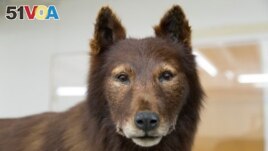05 May 2023
In 1925, a male sled dog named Balto led a 13-dog team through an extreme snowstorm during the final part of a 1,088-kilometer trip. The trip brought lifesaving medicine to the Alaskan city of Nome during an outbreak of the disease diphtheria.
Sled dogs pull sleds, which are small vehicles with a flat bottom that are used for moving over snow or ice.
Balto was celebrated as a hero. He became the subject of books and movies. His preserved body still stands at the Cleveland Museum of Natural History in the state of Ohio.

The taxidermy mount of Balto is displayed at the Cleveland Museum of Natural History in this undated photo. (Cleveland Museum of Natural History/Handout via REUTERS)
Recently, scientists took DNA from Balto's preserved body and studied it as part of a large project called Zoonomia. The massive study compares genetic information in different animals and humans.
Balto's genome, the scientists found, had certain genes that may have helped the dog deal with the extreme Alaskan environment and make it through the difficult trip.
Balto belonged to a population of working sled dogs in Alaska. The population was found to have greater genetic diversity and genetic health than modern dogs.
Diphtheria is a serious and sometimes deadly bacterial infection. When it spread among Nome's people, its port was blocked by ice. Sled dogs were the only way to get the important medicine to the city.
Balto was one of 150 dogs that pulled sleds for parts of the 127-hour trip. During the trip, temperatures reached minus-45 degrees Celsius.
The researchers examined Balto's genome as a part of a dataset of 682 genomes from modern dogs and their animal ancestors, the wolf. The research also included the genes of 240 mammals and genes from humans.
Balto's genome showed lower rates of inbreeding than almost all modern dog breeds. Inbreeding is when animals are born from closely related parents. His genome also showed a lower rate of rare and possibly damaging genetic differences.
Balto was found to share ancestry with breeds like modern Siberian huskies and Alaskan sled dogs. He also was found to share ancestry with Greenland sled dogs, Vietnamese village dogs and Tibetan mastiffs. There was little evidence of wolf ancestry.
Born in 1919, Balto was part of a population of sled dogs imported from Siberia, known as Siberian huskies. The study showed that these dogs greatly differed from modern Siberian huskies, however. Balto had a body built for strength and not speed, which his breeder did not necessarily like. The breeder had the dog's sex organs removed so he could not be used to produce young dogs.
Balto's life after that Alaska trip was a difficult one. He was mistreated by humans. Thankfully, a visiting Cleveland businessman saw Balto's mistreatment and bought the dogs for $1,500. The money was raised by the local community in Cleveland.
In 1927, Balto and his dog co-runners Alaska Slim, Billy, Fox, Old Moctoc, Sye, and Tillie were celebrated in Cleveland on their arrival. They then spent the rest of their lives cared for at the local Brookside Zoo. Balto died of natural causes in 1933.
Kathleen Morrill is the study's co-writer and a scientist at the biotech company Colossal Biosciences. She said of Balto's heroic mission, "These specialized dogs don't know that what they do has such gravity in people's lives."
She added that the sled dogs' genetic makeup "set them up to be the best animals for the job."
I'm Gregory Stachel
Will Dunham reported this story for Reuters. Gregory Stachel adapted it for VOA Learning English.
__________________________________________________________________
Words in This Story
preserve v. to keep (something) in its original state or in good condition
diversity – n. the quality or state of having many different forms, types, ideas, etc.
mammal – n. a type of animal that feeds milk to its young and that usually has hair or fur covering most of its skin
gravity – n. extreme importance; a very serious quality or condition